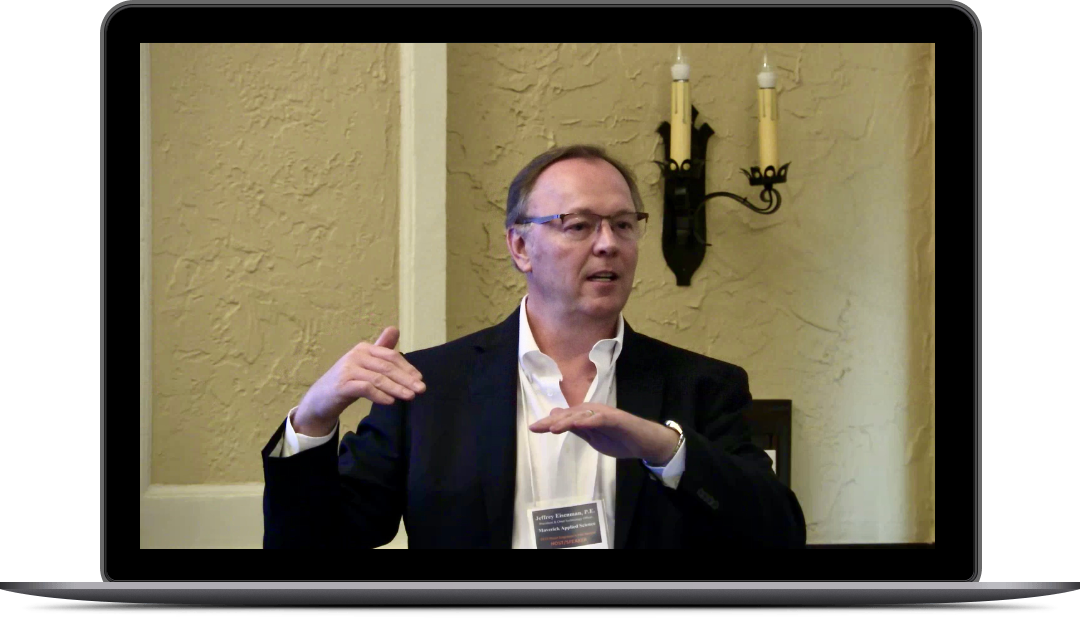Glossary of Terms
Every industry has its own technical terms and jargon, sometimes more than one term for the same item. While by no means all-inclusive, this glossary contains many of the most common terms used in the world of FRP piping systems.1
Acoustic Emission (AE) – When a laminate becomes deformed or cracks, you can actually hear it. Acoustic emission monitoring is a non-destructive test (NDT) used to locate and assess the status of the laminate by listening to acoustic emissions.
Bi-directional laminate occurs when the fibers of a reinforced plastic laminate go in various directions.
Binder – The bonding agent that keeps the individual fibers together.
Blister – Justwhat it sounds like, a blister on the surface of a plastic is not good. It may contain fluid or air and is a sign of weakness in the material.
Bond strength – Also called “peel strength”, this is the amount of stress needed to detach a material from the base it is bonded to.
Bromine – Resinscan be flammable. Bromine, combined with other chemicals, acts as a fire retardant and reduces or in some cases eliminates this potential hazard.
Butt wrap joint – A method of attaching two plain end pieces of FRP equipoment.
Composite – When you assemble a combination of reinforcing materials and compatible matrix resin, you create a composite. The type of materials used result in specific properties suitable for your application.
Cure – Curing is the process of changing a resin’s properties using a chemical reaction. Usually you use either heat or a catalyst or both. If you need to speed up the process of curing a compound, you use a Catalyst. If you want to speed up the chemical reaction between the catalyst and the resin, you may use an Accelerator. A Promoter is a chemical that is a weak catalyst. Post-cure occurs when you expose a cured resin to a higher temperature than those in the curing process. This is necessary for some resins to each their maximum properties.
Creep – Over a period of time, the load can slowly cause plastic to deform and change its dimensions.
A Dead load is when a load on an FRP structure is permanent and remains unchanged.
Delamination occurs when the layers of a laminated plastic material separate, usually due to the failure of the bond between the layers.
Discontinuity stress – Stress caused from an unexpected change in geometry or other factor.
E glass – Highly esistive, E glass is a borosilicate glass used for glass fibers for reinforced plastics.
E-CR glass is a corrosion-grade glass more corrosion resistant than “E” glass. Its greater resistance to acids and alkalis comes from special treatments of “E” fibers.
Elastic deformation – This is when an object returns to its original state once the load is removed.
Elongation – This is when a deformation is elongated due to tension.
Fiberglass reinforced plastic (FRP) – A widely used term often used (and misused) to describe plastic reinforced with any form of glass fibers.
Filament winding – A process where continuous reinforcements are put over a removable mandrel (a mold) according to defined method determined by the stress conditions it must meet.
Filler – An inert material added to plastic mixes for various reasons. These include reducing the cost or modifying the mechanical properties or the color or texture of the material.
First crack strength – The amount of strain or stress necessary to create damage to the laminate.
Glass reinforcement – Rigid filaments that are cut, woven or matted into reinforcements. Glass reinforcements are distributed in the resin called the Matrix.
Hand lay-up , as opposed to filament winding, calls for manipulating sequential plies of reinforced material by hand onto a mold.
Hoop stress – The stress on a cylinder from either internal or external pressure.
Hydrostatic loads are created by a fluid head.
A Hydrotest uses a static fluid head or an induced pressure to test loads.
. Inhibitors – Inhibitors are used to slow down chemical reactions and extend the storage life of resins.
Isotropic laminates’ strength properties are equal in all directions. Laminates are made up of individual layers of reinforcement, each called a Ply.
Laminates – Layers of reinforcement material bonded together with a binder, pressure and heat.
Liner (Corrosion barrier) – To protect a laminate or prevent leaks, a flexible resin is used to line the interior surface of the FRP pipe.
Live load – The load applied by pressure, vacuum or thermal forces.
A Monomer reacts with other molecules to form a polymer. If the compound contains more than one monomer, it is a Co-polymer.
Penetrant – When fluids penetrate the FRP material, it is a penetrant.
Permeability – When a gas, vapor, liquid or solid pass through a barrier with no physical or chemical change, it has permeability.
Percentage elongation is the term used to express the deformation as a percent of the original length of the object.
Plastic deformation is when the object retains its deformed state even though the load is removed or reduced.
PM – Preventive maintenance involves inspection programs that evaluate and document the condition of a system in order to project future maintenance and replacement requirements.
Polymer – A natural or synthetic organic compound with high molecular weight.
Principle directions – The three perpendicular directions in which stresses (tensile, comprehensive and shear) are located in stress analysis.
Rovings are bundles of untwisted strands or twisted yarns of continuous filaments. They are used in filament winding.
Safety factor – The ratio of ultimate stress to allowable stress..1 Definitions are from a variety of sources.
Shear – The stress caused when two parts of an object slide apart.
Sizing – Treating fibers with starch, oil, wax or other substances to protect the surface and make handling and fabrication easier. The sizing binder must be compatible with the intended resin in the laminate matrix.
Stiffness – The relationship of load and deformation.
Stress corrosion is when corrosion occurs due to stress and where corrosion would not have occurred if there had been no stress.
Stress relaxation is when there is a decrease in stress but the deformation remains. The FRP laminate will maintain its deformation even if thermal and mechanical loads are removed.
Structural laminates are designed to support the specific equipment load.
Thermal gradient – The measurement of temperature changes through the FRP laminate from the interior to the exterior of the equipment.
Thermoplastic – Plastic that softens in higher temperatures and hardens in lower temperatures. The process of heating and cooling may be repeated a number of times.
Thermoset plastic can be cured by heat or chemicals to become infusible and insoluble.
Transient loads are temporary loads.
Transverse crack – A crack occurring in the matrix at right angles to the direction of the reinforcements.
Ultimate tensile strength – The point at which a laminate will rupture from tension loading.
A Unidirectional laminate is when most of the fibers all go the same direction.
Veil – An ultrathin reinforcement layer used in corrosion barriers, veil is often composed of organic fibers as well as of glass fibers.
Warp – The yarn running lengthwise in a woven fabric.
Weeping is when the fluids leak slowly through cracks in the FRP wall.
Weft, on the other hand, is the fibers that run perpendicular to the warp.
Woven roving is heavy glass fiber fabric made by weaving the roving.
Definitions are from a variety of sources.
Join our email list to receive updates and have industry-relevant educational content sent right to your inbox!
Do you want to learn more about FRP practices? Have lunch on us, while we expand your knowledge of nonmetallic equipment. Our team can meet in person or schedule a webinar.

We believe in solving root causes, not patching issues

Inspection Services
Inspection of nonmetallic equipment, make informed decisions on equipment maintenance and maximize system performance.

Pipe Supports
Design and supply of supports to ensure the safety and long-term reliability of FRP and thermoplastic piping systems.

Material Testing
In-depth physical and analytical testing of nonmetallic materials for material validation and failure investigation.
Investigative Engineering
Investigative engineering service to the property and casualty insurance industry, legal community, risk management and other industries.
